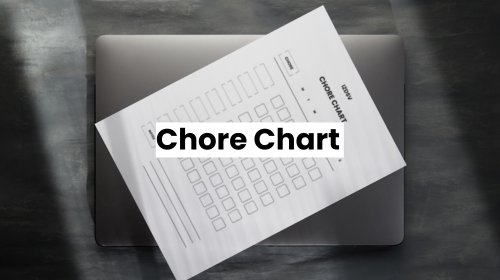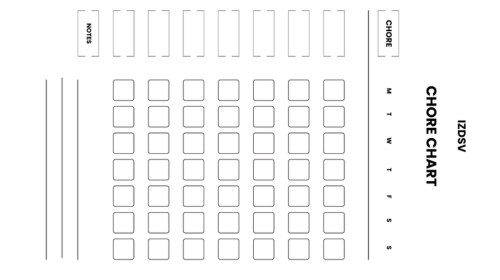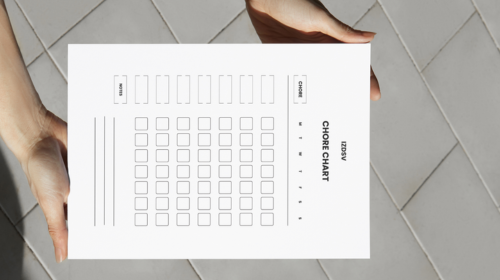Maximize Efficiency with This Comprehensive Chore List for Adults
How Can a Chore List Improve Household Efficiency?
A chore list creates clarity around household responsibilities and helps prevent tasks from being forgotten or duplicated. It serves as a visual reminder that keeps everyone accountable and ensures that necessary work gets completed in a timely manner.
- Establishes clear expectations for each household member
- Prevents arguments about who should do what
- Ensures regular tasks don’t get overlooked
- Distributes workload fairly among household members
- Creates a system that runs without constant supervision
- Reduces the mental load of remembering all household tasks
- Provides satisfaction when completing and checking off tasks
- Makes it easier to track progress and celebrate accomplishments
Benefits of Using a Chore Chart
A chore chart transforms abstract responsibilities into concrete, visual tasks that can be tracked and managed effectively. It creates structure and routine that helps household members develop beneficial habits and time management skills.
- Promotes independence and responsibility, especially for children
- Creates a sense of ownership and contribution to the household
- Reduces nagging and reminders from parents or partners
- Helps teach life skills and work ethic
- Provides visual motivation as tasks get completed
- Can incorporate rewards or recognition systems
- Makes household management more systematic
- Helps identify when tasks are being neglected
- Can be adjusted as household needs change
How to Create an Effective Checklist
An effective checklist should be simple enough to use consistently but comprehensive enough to cover all necessary tasks. It should be designed with input from all household members to ensure buy-in and commitment to the system.
- Start by listing all household chores that need to be completed
- Categorize tasks by frequency (daily, weekly, monthly, seasonal)
- Assign clear ownership for each task based on abilities and schedules
- Use specific, actionable language for each task
- Include estimated time requirements for each chore
- Make the checklist visually appealing and easy to read
- Place it in a central, visible location
- Include space to mark completion or sign off on tasks
- Review and adjust the checklist periodically as needed
Daily vs. Weekly Chores Checklist
Daily and weekly chore checklists serve different purposes and help manage household tasks at different intervals. Daily checklists focus on immediate needs and routine maintenance, while weekly checklists address deeper cleaning and less frequent tasks.
- Daily checklists include quick, routine tasks like dishes, making beds, and wiping counters
- Weekly checklists cover more time-intensive tasks like vacuuming, laundry, and bathroom cleaning
- Daily chores typically take minutes, while weekly chores may take hours
- Daily tasks maintain basic order; weekly tasks prevent the buildup of dirt and clutter
- Daily checklists work well on refrigerator doors or mobile apps
- Weekly checklists might be scheduled for specific days to distribute the workload
- Daily chores usually don’t require special supplies or equipment
- Weekly chores might need coordination of shared resources like vacuum cleaners
What Should Be Included in a Household Chore List?
A comprehensive household chore list should cover all areas of the home and include tasks related to cleaning, maintenance, and organization. The specific items will vary based on your home’s size, layout, and the needs of your household members.
- Kitchen tasks (dishwashing, wiping counters, cleaning appliances, taking out trash)
- Bathroom maintenance (cleaning toilet, shower, sink, mirror, restocking supplies)
- Floor care (sweeping, mopping, vacuuming, spot cleaning)
- Laundry responsibilities (washing, drying, folding, putting away clothes in the closet)
- Dusting surfaces throughout the home
- Changing and washing bedding
- Organizing and decluttering common areas
- Window and mirror cleaning
- Taking out the garbage and recycling
- Watering plants and garden maintenance
- Pet care tasks (feeding, walking, litter box cleaning)
- Mail sorting and paperwork management
Essential Household Tasks for Every Adult
Every functioning adult should master certain household tasks to maintain a clean, organized, and comfortable living environment. These fundamental skills form the foundation of home management and personal responsibility.
- Basic cooking and meal preparation
- Laundry (sorting, washing, drying, folding, ironing)
- Bathroom cleaning (toilet, shower, sink)
- Kitchen maintenance (dishes, counters, appliances)
- Floor care (sweeping, vacuuming, mopping)
- Trash and recycling management
- Bed making and linen changing
- Grocery shopping and pantry organization
- Basic household repairs and maintenance
- Bill payment and financial management
- Seasonal cleaning and organization
- Safety checks (smoke detectors, locks, etc.)
Creating an Ultimate Household Chores List
An ultimate household chores list should be detailed enough to cover all necessary tasks but flexible enough to adapt to your specific household needs. It should serve as a master reference that can be customized based on your home’s requirements and family members’ capabilities.
- Start with a room-by-room inventory of all potential tasks
- Include both visible tasks (vacuuming) and less obvious ones (air filter changes)
- Add seasonal tasks like gutter cleaning and holiday decorating
- Incorporate home maintenance tasks like checking smoke detectors
- Include outdoor responsibilities like lawn care and snow removal
- List administrative tasks like bill paying and appointment scheduling
- Add child and pet care responsibilities if applicable
- Include meal planning, grocery shopping, and food preparation
- Note deep cleaning tasks like baseboards and ceiling fans
- Add vehicle maintenance if relevant
- Include digital organization and backing up files
- Create space for personalized tasks specific to your household
Organizing Your Chore List by Frequency
Organizing chores by frequency creates a structured approach to home management and helps ensure that tasks are completed at appropriate intervals. This method prevents both neglect of important tasks and unnecessary repetition of work.
- Daily tasks (dishes, making beds, wiping counters, quick tidying)
- Every few days (taking out trash, laundry, spot cleaning floors)
- Weekly tasks (vacuuming, mopping, bathroom cleaning, changing sheets)
- Bi-weekly chores (dusting furniture, cleaning mirrors, organizing refrigerator)
- Monthly tasks (deep cleaning appliances, washing windows, organizing pantry)
- Quarterly jobs (seasonal clothing rotation, deep cleaning carpets, washing curtains)
- Bi-annual chores (cleaning gutters, servicing HVAC, washing exterior windows)
- Annual tasks (garage organization, chimney cleaning, checking smoke detectors)
- Seasonal tasks (spring cleaning, fall yard work, holiday preparations)
- As-needed tasks that depend on use (cleaning oven, shampooing carpets)
How to Effectively Use a Chore Chart?
A chore chart is only effective when it becomes an integrated part of your household routine and communication system. The key to success lies not just in creating the chart, but in consistently using and referencing it as part of daily household management.
- Place the chart in a highly visible location (kitchen, entryway, family command center)
- Review the chart daily or at predetermined times
- Create a system for marking completed tasks (checkmarks, magnets, stickers)
- Hold regular family meetings to discuss chart progress
- Acknowledge and celebrate completed responsibilities
- Address missed tasks promptly without blame
- Adjust the chart as needed based on changing schedules
- Use the chart as a reference during household discussions
- Consider digital options that send reminders automatically
- Incorporate the chart check-in as part of morning or evening routines
- Be consistent with consequences for repeatedly missed tasks
- Use positive reinforcement when the system works well
Setting Up Your Adult Chore Chart
Creating an effective adult chore chart requires thoughtful planning and honest assessment of household needs and personal capabilities. The most successful charts balance fairness with practicality and acknowledge individual strengths, preferences, and time constraints.
- Assess all household tasks realistically, including estimated time requirements
- Have an open discussion about strengths, preferences, and availability
- Consider work schedules, commutes, and other commitments when assigning tasks
- Balance the workload equitably among household members
- Choose a format that works for everyone (paper chart, whiteboard, digital app)
- Include rotation systems for less desirable tasks
- Build in flexibility for unexpected schedule changes
- Create clear definitions of what “complete” looks like for each task
- Include space for temporary or seasonal tasks
- Consider color-coding by person or room for visual clarity
- Establish a review period to evaluate and adjust the system
- Make the chart accessible to all household members
Tracking Progress with a Chores Checklist
Tracking progress on household chores provides accountability and creates a satisfying sense of accomplishment when tasks are completed. A well-designed tracking system helps maintain motivation and identifies patterns in household management.
- Use simple symbols for different completion statuses (not started, in progress, complete)
- Include dates or days of the week for time-sensitive tasks
- Consider a weekly reset to maintain fresh tracking
- Take photos of completed projects for greater satisfaction
- Implement a digital tracking system for automated record-keeping
- Use color-coding to quickly identify completed versus pending tasks
- Create a “streak” system to encourage consistent performance
- Include space for notes about unusual situations or challenges
- Review tracking data periodically to identify efficiency opportunities
- Celebrate milestones like “all chores completed this week”
- Address the consistent problem areas revealed by tracking
- Use tracking data to adjust task distribution if certain chores are regularly missed
Delegating Tasks Using a Chore Schedule
Effective delegation through a chore schedule requires clear communication, reasonable expectations, and appropriate task matching based on skills and availability. A well-designed delegation system creates household ownership and reduces the mental load on any single person.
- Match tasks to individual strengths and preferences when possible
- Consider rotating undesirable tasks to share the burden
- Clearly define what successful completion looks like for each task
- Set realistic deadlines that account for individual schedules
- Include a system for communicating when tasks are complete
- Create a process for requesting help or extensions when needed
- Schedule regular reviews to assess how delegation is working
- Allow individuals to swap tasks when needed, with clear communication
- Avoid micromanagement while maintaining quality standards
- Consider pairing more experienced household members with learners
- Include cross-training so multiple people can handle essential tasks
- Implement a backup plan for when an assigned person cannot complete their task
What is the Best Way to Plan Monthly Household Chores?
Planning monthly household chores requires a systematic approach that balances regular maintenance with deeper cleaning tasks. The best monthly plans distribute work evenly throughout the month rather than creating overwhelming cleaning marathons.
- Create a calendar-based system that spreads tasks throughout the month
- Assign specific days for larger monthly tasks (first Saturday for deep cleaning, etc.)
- Group similar tasks together for efficiency (all dusting on the same day)
- Schedule around predictable events and commitments
- Allow flexibility for unexpected schedule changes
- Build in “catch-up days” for missed or incomplete tasks
- Match energy-intensive tasks with your highest energy days
- Coordinate schedules with other household members
- Consider weather-dependent tasks when planning (window washing, etc.)
- Allocate time blocks realistically based on task requirements
- Include both indoor and outdoor monthly maintenance
- Review and adjust your plan quarterly based on changing seasonal needs
Creating a Monthly Cleaning Schedule
A monthly cleaning schedule provides structure for tasks that don’t require daily or weekly attention but are essential for home maintenance. Creating a well-designed monthly schedule prevents tasks from being forgotten and maintains your home’s condition over time.
- Start with a blank monthly calendar or a dedicated planning tool
- List all monthly cleaning tasks that need to be completed
- Estimate realistic time requirements for each task
- Distribute tasks evenly throughout the month to prevent overwhelm
- Consider batching similar tasks on the same day (all high dusting, etc.)
- Schedule more intensive tasks for days with fewer commitments
- Color-code by room, person responsible, or task type
- Include specific details for complex tasks (products needed, steps)
- Add recurring calendar reminders for each scheduled task
- Consider energy levels when scheduling (morning person vs. night person)
- Build in buffer days for unexpected delays
- Review and adjust the schedule quarterly based on effectiveness
Key Monthly Tasks to Include
Monthly cleaning tasks focus on areas that don’t require weekly attention but would deteriorate if neglected for longer periods. These tasks address deeper cleaning needs and maintenance requirements that keep your home functioning well.
- Deep clean appliances (dishwasher, washing machine, refrigerator coils)
- Vacuum furniture and under cushions
- Wash or vacuum curtains and blinds
- Clean vents and replace air filters
- Descalcify coffee makers and kettles
- Clean and organize the refrigerator and freezer
- Dust ceiling fans and light fixtures
- Clean cabinet fronts and hardware
- Wipe down baseboards and door frames
- Clean the inside of trash cans and recycling bins
- Check and clean drains in all sinks and tubs
- Dust bookshelves and decorative items thoroughly
- Clean range hood filters
- Vacuum mattresses and rotate if needed
- Clean and polish wood furniture
- Check smoke detectors and carbon monoxide alarms
Integrating Seasonal Household Chores
Seasonal chores address the changing needs of your home throughout the year and help prepare for upcoming weather changes and holidays. Integrating these tasks into your monthly planning ensures they get completed at the optimal time.
- Create a master list of seasonal tasks for each season (spring, summer, fall, winter)
- Schedule seasonal tasks during the first month of each season
- Prioritize weather-dependent tasks when conditions are favorable
- Group seasonal tasks by indoor/outdoor categories
- Include preparation tasks for upcoming holidays and events
- Schedule seasonal clothing rotation and storage
- Plan seasonal maintenance like gutter cleaning before they’re needed
- Add weather-specific tasks (winterizing pipes, cleaning AC units)
- Check seasonal equipment before it is needed (snow blower before winter)
- Schedule seasonal deep cleaning (spring cleaning, fall preparation)
- Plan garden and yard tasks according to the growing seasons
- Include preventative maintenance that varies by season (checking insulation before winter)
- Adjust cleaning routines based on seasonal factors (more frequent floor cleaning during muddy seasons)
How Can a Cleaning Checklist Simplify Housework?
A cleaning checklist transforms the overwhelming task of maintaining a home into manageable, concrete steps that can be systematically addressed. It eliminates the mental burden of remembering what needs to be done and provides a clear roadmap for household maintenance.
- Reduces decision fatigue by predetermining what tasks need attention
- Creates a visual reminder system that keeps tasks from being forgotten
- Breaks large cleaning projects into smaller, manageable tasks
- Provides satisfaction through the act of checking items off
- Helps distribute workload fairly among household members
- Establishes clear expectations for what “clean” means in your home
- Prevents arguments about who should do what and when
- Creates a system for tracking progress over time
- Makes it easier to delegate tasks to children or other household members
- Ensures consistent cleaning rather than reactive scrambling
- Helps identify patterns in what gets neglected
- Reduces cleaning anxiety by providing structure and boundaries
Daily Household Chores to Keep on Track
Daily household chores create the foundation for a functional home environment and prevent mess from accumulating to overwhelming levels. These quick maintenance tasks take minimal time individually but collectively make a significant impact on your home’s cleanliness.
- Make beds immediately after waking
- Wash dishes after each meal or load/unload the dishwasher
- Wipe kitchen counters and stovetop after cooking
- Do a 5-10 minute pickup of the main living areas
- Sort mail immediately and discard junk
- Hang up clothes or put in hamper (no floor piles)
- Wipe bathroom counters and sinks after use
- Sweep the kitchen floor for crumbs and spills
- Take out trash and recycling as needed
- Put away items left out before bedtime
- Quick-clean pet areas (litter boxes, food areas)
- Wipe up spills immediately when they happen
Weekly Cleaning Tasks to Maintain Order
Weekly cleaning tasks address areas that need regular attention but not daily maintenance. These tasks form the core cleaning routine that maintains overall home cleanliness and prevents buildup of dirt and clutter.
- Vacuum all floors and rugs thoroughly
- Mop hard surface floors in the kitchen and bathrooms
- Clean toilets, showers, and bathtubs
- Change and wash bed linens
- Dust furniture, shelves, and decorative items
- Clean mirrors and glass surfaces
- Wipe down doorknobs, light switches, and remote controls
- Clean the microwave interior and exterior
- Clean out the refrigerator of old food items
- Wash bath mats and kitchen rugs
- Empty all trash cans and clean if needed
- Clean the inside of the kitchen sink and garbage disposal
- Tidy and organize the main living areas more thoroughly
- Launder towels and washcloths
- Clean the stove top thoroughly
- Disinfect high-touch surfaces throughout the home
Deep Cleaning: When and How to Scrub
Deep cleaning addresses areas that don’t require frequent attention but need occasional thorough cleaning to prevent long-term buildup and deterioration. These more intensive cleaning tasks typically require specific cleaning products and more time to complete properly.
- Schedule deep cleaning tasks quarterly or seasonally
- Focus on one room or area at a time to prevent overwhelm
- Clean inside ovens using appropriate cleaners and techniques
- Wash windows inside and out, including tracks and frames
- Clean under and behind furniture and appliances
- Wash walls, baseboards, and crown molding
- Shampoo carpets and upholstery or hire a professional service
- Clean drapes, curtains, and blinds thoroughly
- Descalve showerheads and faucets with a vinegar solution
- Clean grout in tile floors and showers
- Wash light fixtures and ceiling fans
- Deep clean mattresses (vacuum, spot clean, deodorize)
- Clean inside cabinets and drawers
- Wash trash cans with disinfectant
- Clean out gutters and exterior drains
- Pressure wash exterior surfaces when needed
- Deep clean washing machine and dishwasher interiors
Tips for Staying Motivated with Your Chore List
Maintaining motivation for household chores can be challenging, especially when facing competing priorities and natural resistance to cleaning tasks. Creating systems that boost motivation and make chores feel less burdensome is essential for long-term cleaning success.
- Connect chores to your personal values (clean home for family wellbeing, self-respect)
- Break larger tasks into smaller, more manageable chunks
- Use a timer to create focused cleaning sprints (15-30 minutes)
- Create an energizing playlist specifically for cleaning sessions
- Pair less enjoyable tasks with something pleasant (podcast while cleaning)
- Take “before and after” photos to see visible progress
- Focus on how good you’ll feel when the task is complete
- Establish a regular routine so chores become habitual
- Clean alongside a friend or family member for social motivation
- Set a specific goal for each cleaning session
- Change up your approach to prevent boredom
- Challenge yourself to beat previous cleaning times
- Try different cleaning products or tools to make tasks more interesting
- Practice gratitude for having a home to clean
Using a Tracker for Accountability
A well-designed chore tracker transforms abstract cleaning goals into measurable actions that can be monitored and celebrated. Trackers provide visual evidence of progress and help identify patterns in household maintenance.
- Choose a tracking format that appeals to you (paper, digital app, whiteboard)
- Make tracking visible in a prominent location
- Use satisfying methods for marking completed tasks (checkmarks, stickers)
- Track streaks of consecutive days to build momentum
- Include space to note how long tasks actually took
- Add a difficulty rating to acknowledge challenging tasks
- Use color-coding to categorize different types of chores
- Take weekly photos of your tracker to see progress over time
- Share your tracker with household members for accountability
- Review your tracker regularly to identify patterns
- Adjust your system based on what the tracker reveals
- Create special markers for tasks completed on time or early
- Consider tracking mood before and after cleaning sessions
- Use the tracker to identify your most productive cleaning times
Rewards for Completing House Chores
Strategic rewards can transform cleaning from a dreaded obligation into an activity with positive associations. Well-chosen rewards acknowledge effort and create motivation that sustains long-term cleaning habits.
- Create a points system where completed chores earn points toward rewards
- Allow yourself small daily rewards for completing routine tasks
- Save larger rewards for completing challenging or disliked chores
- Choose rewards that don’t undermine your cleaning efforts
- Establish a cleaning “allowance” to spend on something special
- Create a “self-care after chores” ritual (bath, reading time)
- Plan social activities as rewards for completing major cleaning projects
- Use a jar system where completed chores earn tokens toward rewards
- Schedule “cleaning power hours” followed by relaxation time
- Create a visual progress bar toward a specific reward
- Share your accomplishments on social media for recognition
- Take yourself out for coffee after completing your weekly chores
- Establish a monthly “clean home celebration” with a special meal or activity
- Choose rewards that align with your personal values and goals
Involving Family in the Cleaning Schedule
Creating a family-wide approach to household cleaning distributes responsibility fairly and teaches important life skills to children. Effective family cleaning systems balance individual accountability with teamwork.
- Hold a family meeting to establish cleaning expectations and responsibilities
- Match tasks to age-appropriate abilities and strengths
- Create visual chore charts for younger children with pictures
- Establish a regular “family clean-up time” where everyone works simultaneously
- Implement a “team cleaning” approach for larger tasks
- Create friendly cleaning competitions between family members
- Acknowledge and praise efforts, not just results
- Teach proper cleaning techniques rather than assuming knowledge
- Allow input from all family members when creating the schedule
- Establish consequences for consistently missed responsibilities
- Create a rotating schedule for less desirable chores
- Implement a “clean-up song” for younger children
- Use a family reward system for collective cleaning achievements
- Consider special family jobs for weekends when everyone is home
- Hold regular check-ins to address challenges and celebrate successes
- Create a system for requesting help when tasks become overwhelming




